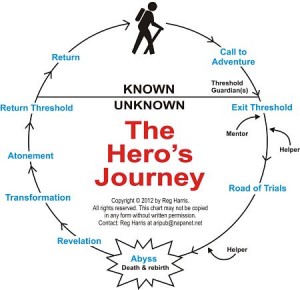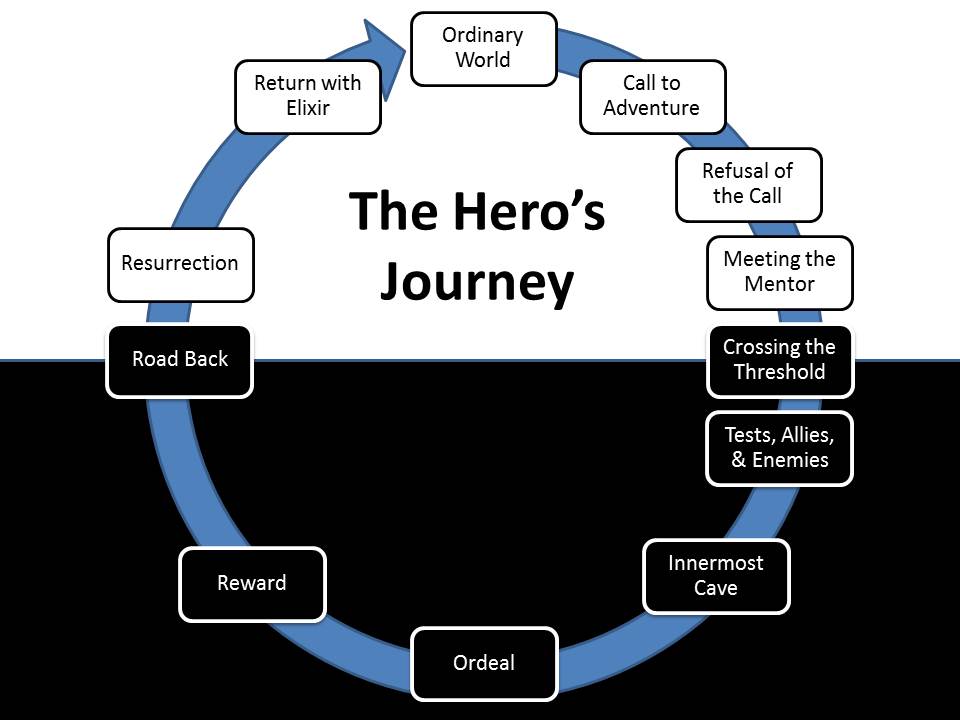There is also a lost episode called The Magician, and four others (= 22 total).
scene from Arrival
I am not a number, I am a person
Rover
trailer introduces Arrival


I've wondered for a bit about the connection to The Prisoner, because of Scott Apel's theory that The Prisoner is also a 3-act play. He made this theory clearer by re-shuffling the episode order of the series. Apel also says that The Prisoner, like the tarot, is a symbolic allegory describing a quest for spiritual liberation. The Prisoner, starring Patrick McGoohan (b. March 19, 1928 - d. Jan.13, 2009), and created in the magic years 1966-67, is the story of a spy (probably John Drake, McGoohan's character from his previous spy series, Secret Agent aka Danger Man) who resigned, but was then immediately taken to The Village, perhaps a place for people who know too much. The leaders of the Village want to know why he resigned, but he won't say, because they themselves won't admit which "side" they are on ("that would be telling"). The Village is a self-contained, prison society where everyone is a number (remember the theme song of Secret Agent, McGoohan's previous series: "they've given you a number, and taken 'way your name"). The Prisoner's number is 6, and according to Apel, in his quest to understand and escape from The Village, he takes a journey of self-discovery or individuation, revealing Jungian themes. McGoohan himself clearly labelled his series as a symbolic "allegory." Also related to this is Jungian scholar Joseph Campbell's theory of the Hero's journey, which says that stories such as Plato's myth of the cave, the Buddha and Christ stories; even stories like The Odyssey, Star Wars, Jason and the Argonauts, Sinbad, etc, are similar accounts of the journey of a person to enlightenment or victory over death. So how about The Prisoner? Is it a Campbell-related hero's journey? And is there a connection to the tarot trump cards, which reveal the same journey?
See the opening sequence on You Tube
Intro and closing credits
Scott Apel's introduction to the Prisoner
Well, there are 21 major trump cards in the tarot, with one wild card The Fool. It is often used today to guide people through their lives, or for fortune telling, but originally (and in some places today) it was just another card game, now familiar to us as bridge. The first bridge games were played with the early tarot deck. But tarot was originally called "cards of triumphs" (carta di trionfi in Italian); a deck of cards with triumphs (trumps) added. Our word trump means triumph over, and comes from tarot and from the elaborate, festive triumph parades in Renaissance times on which tarot was based. Each costumed figure in a triumph parade was supposed to supercede the one before, and by this means the parade told a story or allegory. The trumps in the tarot are a parade of the same kind. Later bridge was played without the extra cards, and tarot became the new name to distinguish it from ordinary card decks used for bridge. But the allegory painted on the 21 trump cards remained and became the basis of the modern tarot deck.
My favorite piece of music, an organ work by Bach called Toccata in F, is also a "hero's journey" in music and is related to these things.
There are 21 phases in the story told by the tarot trumps; one episode per card. Each trump card is numbered to specify its position in the story. Tarot commentators agree that these 21 cards can be divided into 3 parts. There are 17 episodes of The Prisoner, in 3 similar parts. Almost a match. Here is an outline of the 3 acts in the Tarot, and the 3 acts of The Prisoner (more-or-less as laid out by D. Scott Apel in his new episode order):
Act One
Trump 0 The Fool = Arrival
Trump 1 The Magician is also found in Arrival
Trump 2 The High Priestess = Dance of the Dead
Trump 3 The Empress appears in Free For All
Trump 4 The Emperor = Free For All
Trump 5 The Pope = Checkmate
Trump 6 The Lovers = Chimes of Big Ben
Trump 7 The Chariot = Many Happy Returns
Act Two
Trump 8 Strength = Schizoid Man
Trump 9 The Hermit = The General
Trump 10 Wheel of Fortune = A B & C
Trump 11 Justice = Living in Harmony
Trump 12 The Hanged Man appears in Living in Harmony
Trump 13 Death = It's Your Funeral
Trump 14 Temperance = Do Not Forsake Me
Act Three
Trump 15 The Devil = A Change of Mind
Trump 16 The Tower = Hammer into Anvil
Trump 17 The Star = The Girl Who Was Death
Trump 18 The Moon also = The Girl Who Was Death
Trump 19 The Sun = Once Upon a Time
Trump 20 Judgement = Fall Out
Trump 21 The World = Fall Out
Here in more detail is how The Prisoner episodes, and their symbols, match up with the tarot. I wonder if this is an idea for Mr. Place or another artist to create a Prisoner tarot deck! By the way, it is important to point out that, according to Apel, Patrick McGoohan himself validated Apel's episode order and said it was correct, even though the episodes are usually shown in a different, more jumbled-up order.
| On Arrival in The Village the Prisoner is a Fool (card zero), who doesn't know where he is, but meets a few guides (the Magician) who give him clues (epecially the woman who gives him the key to fly the helicopter). He claims to be a person, not a number; the theme of the quest. Interestingly, The Fool, who in the tarot deck represents the seeker on the journey itself, rather than one of the 21 stages of the journey, is often given no number, or else the number zero. The Prisoner, of course ("fool" that he may be), insists that he is not a number, and refuses to wear his number badge. The Fool and the Prisoner are both symbols of "everyman" (The Prisoner series was produced by "Everyman Films"). In the penultimate episode Once Upon a Time (which McGoohan wrote), the Prisoner explicitly states that he is a "fool." One of the documentaries linked below states that the name Everyman Films was chosen because The Prisoner story is based on a medieval allegory called Every Man, which very likely is the same story ("The Fool's Journey") depicted in the tarot's 22 trump cards (major arcana).
There is also a lost episode called The Magician, and four others (= 22 total).
|  
|
|
In Dance of The Dead the prisoner meets the mysterious, calm and confident High Priestess (card #2) who, except for 2 other cases seen only briefly, is the only lady #2 during the whole series (#2 is the leader of the village, but changes from episode to episode; the question being "who is #1??"). People dressed in costumes and masks for a carnival in this episode might reflect the esoteric secrets concealed by the High Priestess and her rituals. And she even tries to administer the secret Law she holds on her lap in the tarot card by putting the Prisoner on trial. The Prisoner site, under "episode guide," shows this scene (see right), which looks just like the card, with the Priestess on the throne and a male and female figure on each side (equivalent to the left and right columns on the card). The two figures are even dressed in black and light colors, like the columns on the Priestess card.
Interestingly, McGoohan himself put this episode third after Free For All, with Checkmate 4th, apparently confirming my theory that the sacred rulers (Priestess and Pope) could come after the secular ones (Emperor and Empress) in the Tarot sequence. Scott Apel's commentary on Dance of the Dead
|  | 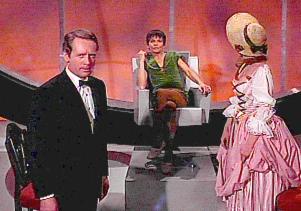
|
|
In Free for All the Prisoner is coaxed into running in and winning a phony election to be #2 (The Emperor, card #4), but when he tries to rule and liberate the people, he is taken down by his own lady assistant, who assumes command as #2 (The Empress, card #3). In our day and age, would-be emperors must stand for election. But is anything different?
trailer introduces Free For All
|  
|
|
In Checkmate the Prisoner (aka #6) is placed on a human chessboard with a rook, a queen, a king and a bishop. Then he asks "who are the warders?" (or guardians). In other words, he wants to know who among the Village residents are the true believers who obey the The Pope (Hierophant) and follow his religion, and enforce his edicts, and who are not. He gets together a group of non-believers to try to escape, and they follow him and believe in him as a new "pope," but they end up wondering whether the powerful #6 is really a warder too. The Pope or Hierophant is trump #5.
trailer introduces Checkmate episode
|  | 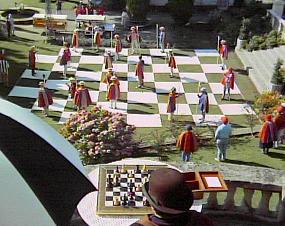
|
|
In Chimes of Big Ben #6 is betrayed by a female partner (played by Nadia Gray) in an escape attempt, and at the end reveals that his decision to resign "was a matter of conscience." His partner in this episode was his closest working relationship with a female during the series. They even speak "the language of love" (according to #2), and Nadia wonders if the Prisoner is "engaged". Thus, this episode corresponds to The Lovers card #6, where a choice or decision (conscience) is also made between higher and lower motives. The prisoner, at the behest of #2 (Leo McKern), makes the decision to "join in" with the activities of the Village, which he will do more of in future episodes-- although for his own purposes (in this case to make a sculpture for a crafts fair which becomes a boat to escape in). Thus the prisoner has made the decision to "join" and accept the challenge of his journey of liberation within The Village, the choice presented on the Lovers card.
trailer with scenes from Chimes of Big Ben
| 
|
|
In Many Happy Returns the Prisoner is allowed to escape and actually travels (as in a Chariot, card #7) all the way back to London England, but is returned to The Village. While in London he returns to his old house, where the new occupant (who turns out later to be #2) needs help with her car, which was originally the Prisoner's own car (KAR120-C, the Lotus Seven; another symbolic reference to The Chariot). He proudly reminds her that he knows "every nut and bolt and cog; I built it with my own hands!"
trailer introduces Many Happy Returns
| 
|
|
Schizoid Man could represent Strength (trump card #8), because the prisoner wins his first victory against The Village, which tries to "steal his soul" by creating a double (#12) to confuse his identity. The Prisoner keeps his identity, and his double is killed (tamed). The Lion on the card, whom the lady tames, could represent the double (#12).
Scott Apel's commentary on the Prisoner as a 3-act play, and Schizoid Man as the start of act 2. Apel summarizes the 3 acts with these titles:
|  | 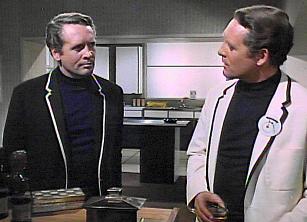
|
The General (a computer), and the reclusive professor who created it, symbolize the quest for knowledge represented by The Hermit (card 9). The Prisoner tells the General that real knowledge is to ask why, not just facts implanted in your mind. The independent-minded Prisoner thus becomes, like the Hermit, the teacher who lights the way for us to true knowledge within The Village.
Scott Apel's commentary on The General
|
| 
|
|
A B & C represent the three figures surrounding the wheel on card #10, Wheel of Fortune. #2 has three chances (A, B & C) to find out why the prisoner resigned. To do so, #2 tries to invade The Prisoner's dreams, but The Prisoner proves to #2 that he did not "sell out." If greed (fortune) had been the prisoner's motive to resign, then he might have sold out; but he was better than that. The series logo (the penny-farthing bike) has Wheels too, and represents blind material "progress" (or fortune), which McGoohan later said The Prisoner series protests against.
trailer introducing A B & C
| 
|
In Living in Harmony the Prisoner meets "the Judge" (Justice, card 11), who says decisively, "let justice be done." In a sort of hallucinagenic allegory of the allegorical Village, #6 has resigned as sheriff of a Western town, but is brought to the nearby town of Harmony (another symbol of "justice"), and put in prison. There a woman ("Kathy Johnson") sees her brother strung up and hanged, as in
The Hanged Man (card 12). So she decides to help her new friend The Prisoner escape, and for this she is thrown in jail after a trial. The Prisoner then demands Kathy's release, and the Judge offers to set her free if #6 becomes his sheriff. He accepts the bargain, but the new sheriff finds it a difficult town to master, especially since he refuses to wear a gun, and since "the kid" (the town's best gunslinger) is jealous of Kathy's fondness for The Prisoner.
|
|
 
|
opening scenes from Living in Harmony
The duel: the kid vs. the prisoner
Scott Apel's comments on Living in Harmony, and Prisoner themes in literature
|
It's Your Funeral is symbolized by phase 13, the Death card, as #6 prevents a retiring #2 from being assassinated. We also see the Prisoner gain Temperance (card #14) in this episode, because he is more concerned with helping the people in The Village avoid retribution for the assassination than about his own situation.
trailer introducing It's Your Funeral
| 
|
| In Do Not Forsake Me, Oh My Darling the Prisoner has an identity crisis, as his soul is switched into another body. The Hanged Man (#12) represents a similar identity crisis, as the seeker learns to distinguish his real self from the social self created within us by the society and social authority to which The Hanged Man is a traitor (a rebel like The Prisoner). At the end of this episode, the image of 3 souls transferred among 3 bodies reminds me of Temperance (card 14) in which liquids are poured between different cups. | 
|
A Change of Mind represents The Devil (card 15) as the final adversary who forces the Prisoner to confront his inner demons and "join in with the group spirit." True to form, the #2 in this episode is ugly and menacing, as he administers "the final challenge" to The Prisoner, saying his rebellion can't be tolerated anymore. #2 and his "Committee" attempt to deceive The Prisoner into believing he has been ostracized and given a kind of lobotomy (disabling the frontal lobes of his brain) to rid him of his aggressive impulses (or demons). The Devil represents these impulses within us that threaten to take away our own will, and demonically possess us. But #6 wakes up from the deception and discovers how to master himself and The Village, by turning its powers against its own rulers, instead of "resisting" them (as in Aikido). Interpreters of the tarot say that the chains holding the two figures on the card as captives to The Devil (in this case #6 and #86) are loose enough so that they can free themselves whenever they realize that they can. Similarly, in A Change of Mind the Prisoner realizes after a while that "the operation never actually occured," and he thereby frees himself. This is my favorite episode; the turning point in the journey.
|
trailer introducing A Change of Mind
|  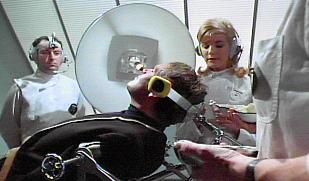
|
|
In Hammer Into Anvil the Prisoner sees a girl fall to her death from The Tower (high hospital window; trump 16). Then he overthrows the cruel and paranoid #2 who forced it to happen, using the "aikido" technique he discovered in the previous episode, just as on the Tower card the power of the Devil is overthrown.
trailer for Hammer Into Anvil
| 
|
above left: Scott Apel's commentary on Hammer Into Anvil, and the Penny-Farthing Bicycle and the change of mind turning point of the previous episode
above right: The Tower by Bruce Dickinson refers to tarot cards and hammer into anvil; with lyrics here
|
According to Scott Apel The Girl Who was Death represents the inner feminine, in Jungian terms. She is also the alluring Mother Nature on The Star, trump 17, and
The Moon (trump 18) is the tarot card symbol for the eternal feminine within us, a card that is also interpreted as representing "unforeseen perils," like the series of deadly traps the Girl sets for #6. Like the Star card, this episode is a break from the turmoil of the previous episodes, because it is a humorous spy-spoof and "a blessed fairy tale." As on the Star card, significant action takes place on both land and sea. At the end of the episode the Prisoner is forced to climb up on a ladder into the nose of a rocket to take a ride. This represents "the flight" stage in the hero's journey, which is also the same as climbing the ladder of planets represented on The Star. The ladder of the rocket has more than 7 steps, I think, but it is a spiral staircase (like the 7 chakras)! (Later in Fall Out the spiral staircase to #1's room does seem to have 7 or 8 steps.) The rocket is also a lighthouse, and at this stage in the tarot we are climbing a ladder of planets of ever-greater light.
The Girl Who Was Death trailer
|  
|
| In Once Upon a Time, The Prisoner achieves victory in a battle to the death with #2, who represents #6's own inner male self according to Apel. This is represented by The Sun (card 19), the eternal masculine, and also a symbol of "time transcended," according to Robert Place (or as #2 said, "degree absolute", beyond life and death). #2 uses a children's story ("Once Upon a Time") to try and convert #6 using hypnotic regression, and The Sun card often features 2 children (or at least one). As on the card, which shows the children ready to leave the "garden," the victorious Prisoner, having survived "the ultimate test," leaves the enclosed space with his escort to seek even greater realization. This will take the prisoner beyond his strong, victorious individualism and his recovered conscious mind represented by The Sun, and down an elevator into a cavern (collective unconscious, according to Apel). By the way, the Sun rules the astrology sign Leo, and #2 who here symbolizes the Eternal Masculine (The Sun) is played by Leo McKern. Leo also rules the 5th house of "children." Notice how #6 gazes up at the powerful, artificial Sun that looms over the proceedings, especially when he says "pop" (father, the inner parent, the eternal male?). | 
|
| In Fall Out, the most allegorical and surrealistic episode, the final stage of the journey is reached, represented by the final two tarot cards. First we see the defeated #2 from the previous episode rise from the dead, just as the Judgement, card #20, shows people rising from their graves. He sees the victorious Prisoner "enthroned at last"-- sitting on a throne (which, counting the floor, has 7 levels), just as The World (card 21) is the "throne of God." Then, after being tempted to take over The Village as a new #2, by a group in skeleton masks led by "the president" assembled to judge him and two other prisoners, #6 breaks out of The Village (assisted by three people: the two other judged prisoners-- the old #2 from the previous episode (Leo McKern), and a rebel youth (#48)-- plus the Butler; which are like the 3 figures being released from their graves on the Judgement card). Everyone evacuates The Village with them too. Then he returns to London-- but ends up appearing in the very same scene with which the series began. Thus we see "the return," a constant theme in Hero's Journey stories, in which the liberated hero returns to share wisdom gained from the adventure with the world. This return is represented by The World card. In London we also see the Prisoner dancing, as if, having achieved his freedom, he is "dancing on the throne of God" (like Lady Sophia on The World card). The rebel hippie youth in this episode (The Fool, the wild card) also jumps around and dances to the song "Dry Bones," which is about resurrection (as pictured on the Judgement card) (the rebel youth may also have been the resurrected "kid" who died at the end of Living in Harmony, played by the same actor, Alexis Kanner). Note that some interpreters place The Fool at the end of the tarot sequence, and he's here too in The Prisoner. "Dry Bones" is based on Ezekiel, in whose vision of God the four animals on The World card had first appeared (at Ezekiel 1:10). In Ezekiel 37 from the Bible, dry bones "hear the word of the Lord," come back to life, and become a liberating army to bring their people home from exile (as the rebels did in The Prisoner). This episode is unique in featuring two popular songs in the soundtrack, and this corresponds to Gabriel's trumpet on the Judgement card. It is calling souls to rebirth, and the songs "Dry Bones" (rebirth) and All You Need is Love (with its powerful "La Marseillaise" trumpet sound opening), also represent the spiritual realization that is at the heart of both this episode, and the last two tarot trump cards. Just before the breakout, #6 gets to meet #1, and learns in some sense that HE himself is #1-- just as The World card represents the realization that "I am God" (I am #1) or the universe (cosmic consciousness), and that we are all prisoners of ourselves. Thus "I" = #1. Notice the globes (the world) in this scene. #1 may also be the resurrected double #6 from Schizoid Man. In fact #6 + #1 = 7, the sacred number (indeed, Six of One, half a dozen of another). And in the very last (and first) scene, the Prisoner rides free in his KAR, which is a Lotus seven, just as the Tarot's trump card #7 is The Chariot. |  
|
All You Need is Love: welcome! from Fall Out
Dry Bones sung and danced to by #48; the Prisoner dances to it in London
Fall Out Revolt All You Need is Love
Dry Bones song (the first words of the song are "Ezekiel cried")
Dry Bones by The Dixie Four
Cathedral Quartet sings Dry Bones, to get these ol bones together Hu-ummmmm.....
The Valley of Dry Bones from Ezekiel
Ezekiel's vision of the throne of God, basis of The World card and analogous to #6's throne in Fall Out
scenes from Fall Out: #48, first of 3 rebels on trial (embedded above). At right, the Prisoner on his throne, with music from Fall Out.
The Prisoner tries to speak
The revolt, to the tune of the would-be toccata, and the beatles
last scenes of Fall Out accompanied by music by Bach! Notice The Prisoner dancing.
The Prisoner visuals on the road to London, narrated by the director
trailer for Fall Out
Robert Place asked me, what about the symbols for the four tarot card suits? Where are they in The Prisoner?
The wands, pentacles (coins), cups, and swords are the main symbols that appear on the other 56 tarot cards, and designate the four suits (similar to clubs, diamonds, hearts, spades respectively). These are not the "major arcana" cards that tell the story of the hero's or fool's journey, but those which are numbered 1 to 10 or which feature royal figures. These four suit symbols are often related to the four elements (fire, earth, water, air), and to other important aspects of our world that come in fours, such as the Jungian four psychological functions; and of course, to the 4 figures in the corners on The World card. Here is a table of these aspects of the fourfold world. I hesitated in answering Place, but I don't know why. It is obvious that there are exactly four symbols that appear over and over again as emblems of The Prisoner series and The Village. These are the umbrella, the penny-farthing bicycle, "rover" (the white mechanized weather balloon that polices the village), and the number badges assigned to each prisoner.
We could more-or-less assign them to the tarot cards suits in the following way: The umbrella can be folded up into a staff, or wand (the fire element). In A Change of Mind it is used as a staff to beat the Prisoner into submission. It provides the protection that standing under the authority of the group-umbrella represents. It could symbolize any over-arching truth, something the prisoners are not allowed to see. Archetypes are often related to the fire element. Related to the word umbrage, the umbrella also represents the fiery anger of the Prisoner against his captives. The penny-farthing bicycle, the official Village logo (which also contains the village salute and the number 6 in its frame) is obviously related to the coin suit (earth element), by virtue of its title. It also represents the runaway material progress which The Village embodies, according to McGoohan, and which we as members of modern society are asked to worship. It (along with the umbrella) signifies the late Victorian era when it was invented, and when this worship of modernism and wealth became predominant. "Rover" the police balloon or guard dog (actually a weather balloon) is related to cups (water). It is said to be a symbol of purity, by virtue of its white spherical nature, and like water it "rounds things out" and dissolves differences-- in this case, any defiance of Village authority. It always arises from the sea. "Weather" represents change and fluidity (water). For the 4th symbol (unlike Apel) I chose the ever-present number badges which all prisoners except #6 and the butler are required to wear (along with the uniform or suit they are attached to). It represents swords (air), because numbers (like swords) cut, separate, define and pigeonhole people, much like our calculating rational minds which love to reduce things and people into numbers. It also defines the theme of the series, "I am not a number." As symbol of the mind, the air element is a good fit for the number badge. You could call it either the suit of badges or the "suit of numbers."
You can see these four symbols in the background in Scott Apel's introductions to Prisoner episodes.
Apel's comments on Rover and The Butler
Scott Apel's commentary on Hammer Into Anvil, and the Penny-Farthing Bicycle, etc.
Scott Apel (in another body) introduces Do Not Forsake Me; then returns to discuss the umbrella symbol
Thanks for reading, and Be seeing you! Comments? You can email me here
The Tarot Journey
Bigger pictures of the tarot trumps
Bach, Chakras, Tarot
Robert M. Place, author of The Tarot: History, Symbolism, and Divination, and Tarot deck creator
The Fool's Journey on You Tube with music by Stewart Copeland
The Fool's Journey by Joan Bunning
The Prisoner website
Excellent summary of The Prisoner by Rick McGrath
Snippets of The Prisoner part 1
Snippets of The Prisoner part 2
scenes from The Prisoner
trailer introduces The Prisoner
trailer introduces The Saint, The Prisoner, Arrival, AB&C, Chimes of Big Ben, Checkmate, & Once Upon a Time
Six of One Prisoner fan club
Bio of Patrick McGoohan by Scott Apel
interview with Patrick McGoohan and the problem of "progress"
Patrick McGoohan "explains" The Prisoner
Part Two
short interview with McGoohan about #1
Kenneth Griffith interview (played Schnipps/Napoleon in The Girl Who Was Death, and The President in Fall Out)
Sci-Fi Channel Documentary, In Search of the Prisoner, part 1
In Search of the Prisoner, part 2
In Search of the Prisoner, part 3
Promos for The Prisoner; scenes from Fall Out and other key episodes: Free for All, A B & C, Hammer Into Anvil
Prisoner music video
Tour of The Village
The Prisoner by Iron Maiden
The Prisoner in Sixes and Sevens, a sequencer music mind-phuck in 6/8 and 7/8 time
A 1955 movie precursor
Articles teaching the Hero' Journey
Joseph Campbell and the Myth of the Hero's Journey
The Hero's Journey Outline, including Christopher Vogler's
The Hero's Journey as explained by Christopher Vogler on you tube
The Ultimate Gift, a contemporary movie version of the hero's journey.
Click here to read the parallels with the tarot and see links to the movie.
The tarot sequence in The Matrix movie no sound
